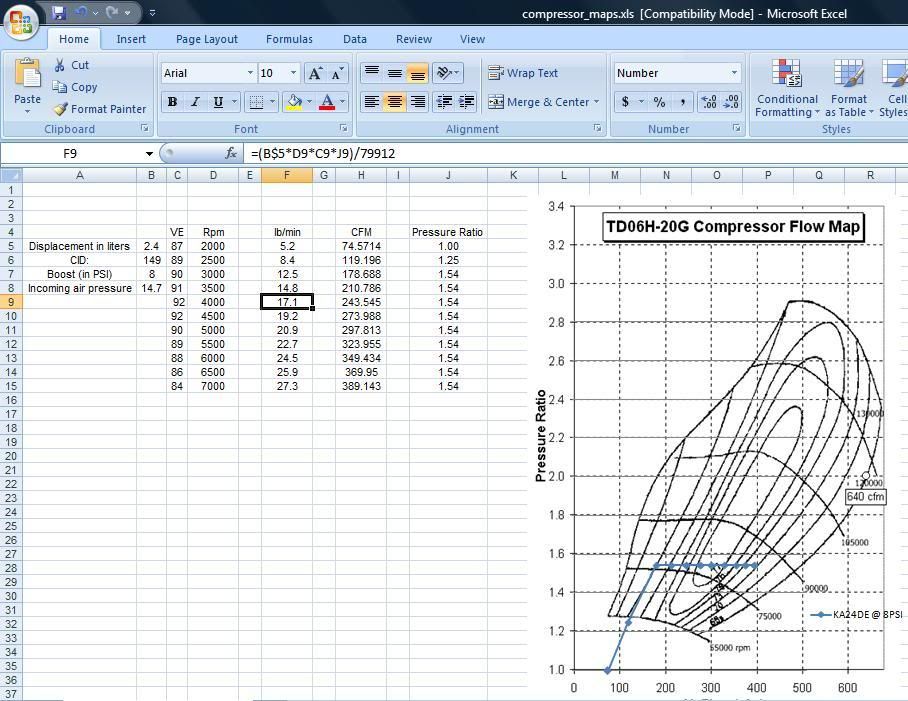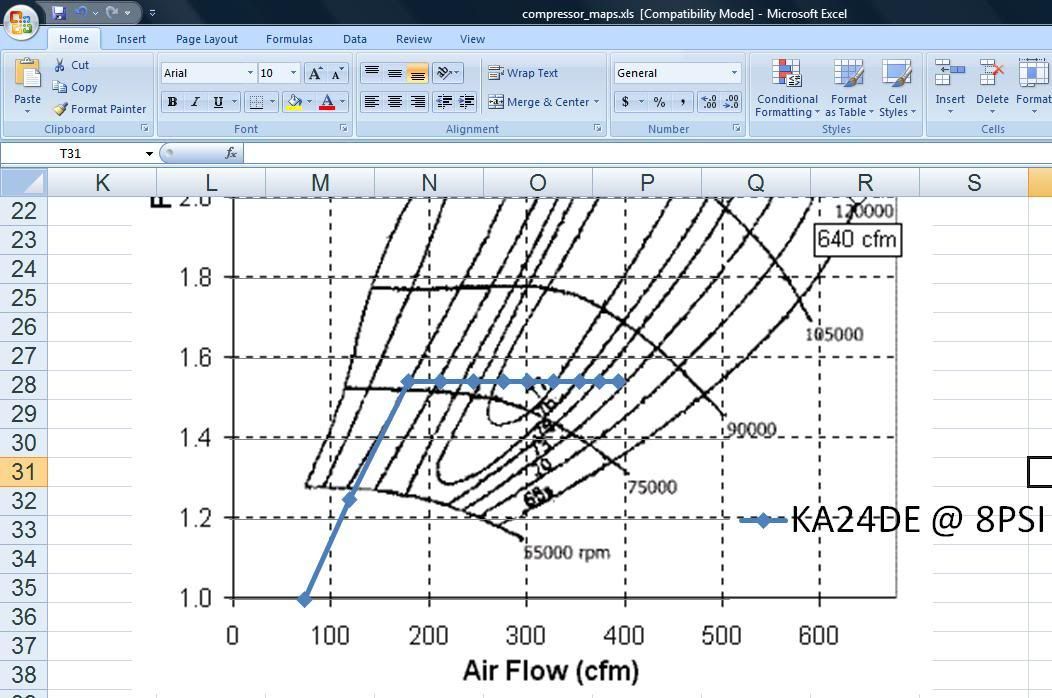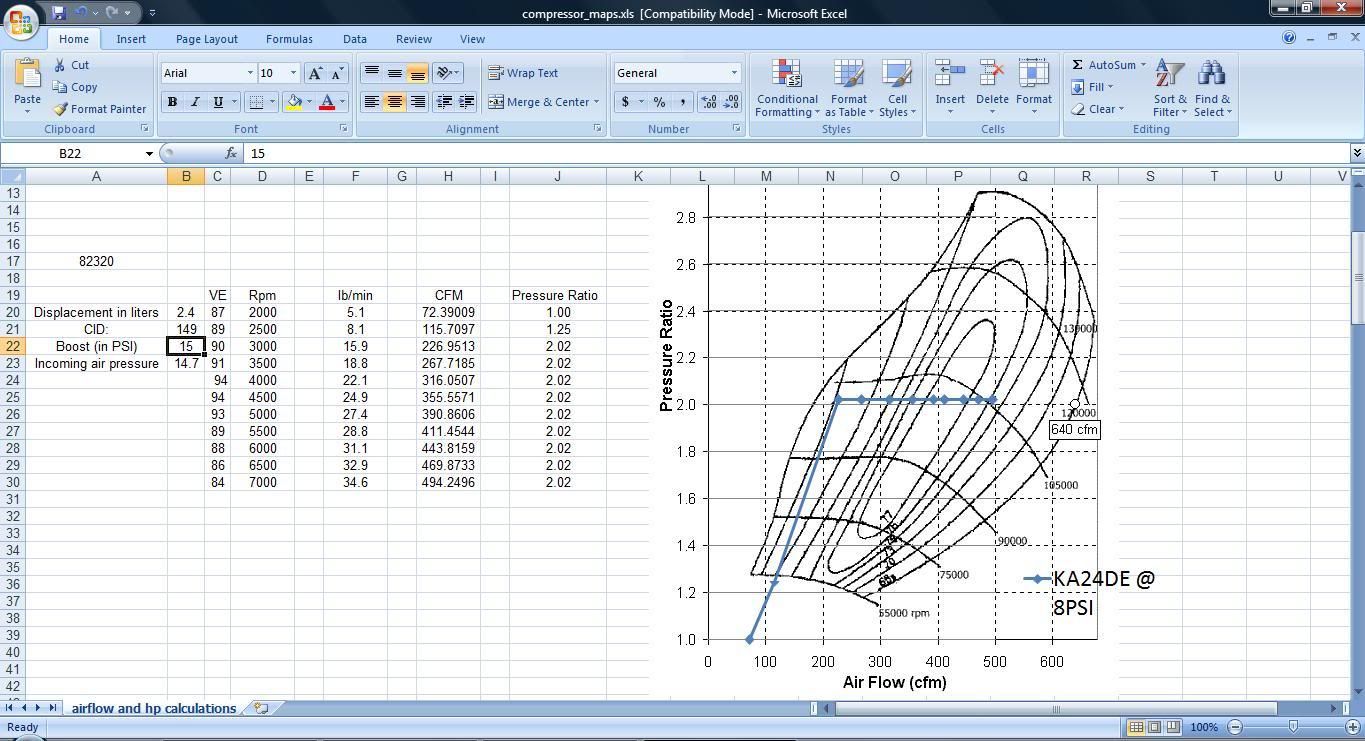CXRacing?
- SiDwAyZ240
- Posts: 273
- Joined: Fri Apr 03, 2009 8:39 am
- Car: 95' SR Slayer, '02 LT Tahoe, '03 Chev Express is the DD
Re: CXRacing?
exactlly...... + the 20G and emanage have plenty of growing room should the urge arise when compared to a t25 or t28 and can still handle most t3s. There are various ways to re-tune a emanage versus sending your ecu off everytime you make a change. Just my opinion cause I'm no expert, but seems pretty effective to me.
- PapaSmurf2k3
- Site Admin
- Posts: 24005
- Joined: Thu Nov 21, 2002 3:20 pm
- Car: 2017 Corvette, 2018 Focus ST, 1993 240sx truck KA Turbo.
- Location: Merrimack, NH
Re: CXRacing?
I always find it easier to discuss things when there is a picture attached, so here it goes:SiDwAyZ240 wrote:So let me try and figure this out:
I used my compressor map cause I wasn't sure what the values were on Papa's.
TD06 20G starts it's peak efficiency at 8PSI and is flowing 17.94 lb/min. (260cfm*.069=17.94). From that 17.94*10= 179.4 HP, right? Is that addittional HP that you add to stock? Seems a little high so I'm assuming you would be capable of 179.4 HP total with the proper fuel. Meaning an increase of roughly 15HP over stock. That seems a little low, I shoulda paid more attention in physics.

I made a program in excel to plot all this junk for you on the 20G, or any compressor map if you'd like, but lining up Excel's chart with whatever map you import in is sort of a pita. If anyone wants it, PM me your email addy and I'll send it to you.
Anyway, lets take a closer look at the business part of this map.

When you said 260cfm, you were basically going off that efficiency island... and yes, you are correct, it looks like you'd be flowing enough air for ~180hp right there (no, that isn't added to stock, that is just how much power you are making at that time). That point on the map is at a certain RPM level. When you increase RPMs, you increase airflow, as well as power potential.
Now, you guys can basically come to your own mathematical conclusions just by looking at my excel spreadsheet, but I'll include the equations anyway (at least the ones I'm using... they should be more or less correct. Remember though, most of this is just ballpark estimates).
Airflow = ((displacement in liters)xRPMxVolumetricEfficiencyxPressureRatio)/(5600xincoming air pressure)=lb/min
Don't freak out
Most of those are constants when dealing with 1 specific engine. The only things that change are RPM (obviously), and Volumetric Efficiency. Pressure ratio changes somewhat at the lower RPM, but most people don't care about that area anyway (I actually have them plugged in as constants on my spreadsheet, with the rest a mathematical formula). Incoming air pressure again is usually just 14.7 for us single turbo system guys.
You have to estimate your volumetric efficieny based on your RPM (KA's typically peak torque in NA form at what, 4500 rpm?) So shoot for about 94-95 at that rpm, and subtract a little as you stray away from that point. Note: in this equation, Volumetric Efficiency is represented as a whole number, not a decimal (see example).
So what does all that boil down to with a KA?
We'll do an example for 4000 RPM and 8psi of boost:
Airflow = ((2.4*4000*94*1.54)/82320)= 16.9 lb/min or about 240 CFM.
If you're sneaky, you notice that some of my math down here doesn't match my spreadsheet up top, most importantly the denominator constant in the airflow equation. Somehow I had that messed up (had 14.27 instead of 14.7 in there for atmospheric pressure). Other things change as well, such as volumetric efficiency, but you have to change those numbers based on your knowledge of the engine. Engines with variable valve timing typically have better, more consistent volumetric efficiencies than traditional cammed engines.
Also, just to show you guys I'm not kidding around about this spreadsheet, here it is at 15 psi. I literally changed 1 number (the boost on the left hand side of the spreadsheet). This will change your lines on the compressor map and show you if you're blowing past its efficiency range, and how much air you are pumping.

Disregard that legend, as this map is no longer for 8psi.
- PapaSmurf2k3
- Site Admin
- Posts: 24005
- Joined: Thu Nov 21, 2002 3:20 pm
- Car: 2017 Corvette, 2018 Focus ST, 1993 240sx truck KA Turbo.
- Location: Merrimack, NH
Re: CXRacing?
This is very NOT recommended. IF everything is perfect, pistons typically let go around 400hp, rods at 500 (after a few dozen pulls). Typically everything ISN'T perfect though. Stock pistons vaporize at those power levels with even the slightest hint of detonation. Just... don't try itSiDwAyZ240 wrote: I read about stock KA's running 400-500 HP. It's all about the boost and tune and how crazy you are.
I haven't looked into the greddy kit in a LONG time, but I recall them doing something super funky when it first came out, like alter timing to the point that THAT was the boost control... not cool.SiDwAyZ240 wrote:exactlly...... + the 20G and emanage have plenty of growing room should the urge arise when compared to a t25 or t28 and can still handle most t3s. There are various ways to re-tune a emanage versus sending your ecu off everytime you make a change. Just my opinion cause I'm no expert, but seems pretty effective to me.
But yes, as a system it is a pretty good match for the KA. There are better tuning systems than the Emanage out there for sure, but if you can score a good deal on a Greddy kit, then go for it.
- SiDwAyZ240
- Posts: 273
- Joined: Fri Apr 03, 2009 8:39 am
- Car: 95' SR Slayer, '02 LT Tahoe, '03 Chev Express is the DD
Re: CXRacing?
Nice spreedsheet, can I get that email: [email protected]
I absolutely was not recommending trying to run 400-500 on stock internals, but just mearly stating that it has been done. Me personally would never try to run 375+ with out a motor build. My point was that the Greddy setup is just about perfect for what Gundyy was trying to accomplish plus leaving plenty of room when he decideds to build heavy, a more reliable setup than piecing, and still coming in under his original 2K budget. I've still don't have any experience tuning the emanage but I believe it will be a user friendly start to learning the tuning process. The added bonus to the KA Greddy kit being its already tuned so it's plug and play.
I absolutely was not recommending trying to run 400-500 on stock internals, but just mearly stating that it has been done. Me personally would never try to run 375+ with out a motor build. My point was that the Greddy setup is just about perfect for what Gundyy was trying to accomplish plus leaving plenty of room when he decideds to build heavy, a more reliable setup than piecing, and still coming in under his original 2K budget. I've still don't have any experience tuning the emanage but I believe it will be a user friendly start to learning the tuning process. The added bonus to the KA Greddy kit being its already tuned so it's plug and play.
- PapaSmurf2k3
- Site Admin
- Posts: 24005
- Joined: Thu Nov 21, 2002 3:20 pm
- Car: 2017 Corvette, 2018 Focus ST, 1993 240sx truck KA Turbo.
- Location: Merrimack, NH
Re: CXRacing?
Email sent!SiDwAyZ240 wrote:Nice spreedsheet, can I get that email:
Razi wrote:Papa, I love you.
-
Gundyy
- Posts: 26
- Joined: Wed Mar 30, 2011 5:16 pm
- Car: 2000 Dodge Dakota 4.7L 4x4
- Location: Toronto, Canada
Re: CXRacing?
so the pressure ratio is the absolute pressure(boost+atmospheric)/atmospheric pressure?
also, found this for calculating CFM
http://www.lovehorsepower.com/joomla/in ... &Itemid=49
very helpful, also the turbo tech section from Garrets website has a 3 step explanation, very long and similar to yours.
according to their site and formula, for 250hp i need 10.3psi of boost?
also, found this for calculating CFM
http://www.lovehorsepower.com/joomla/in ... &Itemid=49
very helpful, also the turbo tech section from Garrets website has a 3 step explanation, very long and similar to yours.
according to their site and formula, for 250hp i need 10.3psi of boost?
- PapaSmurf2k3
- Site Admin
- Posts: 24005
- Joined: Thu Nov 21, 2002 3:20 pm
- Car: 2017 Corvette, 2018 Focus ST, 1993 240sx truck KA Turbo.
- Location: Merrimack, NH
Re: CXRacing?
Usually there are far too many variables to just say "you need x amount of boost for x amount of power". Larger turbos flow MORE air at the same boost levels as smaller turbos.Gundyy wrote: according to their site and formula, for 250hp i need 10.3psi of boost?
Think of it like a hose. You can get more water out of a bigger hose as you can out of a smaller hose at the same pressure.
OR, if electronics is your thing... boost is like voltage, and airflow is like amps. You get more amps out of a bigger turbo (which equals more power... both electronically and engine wise).
Get it?
-
Gundyy
- Posts: 26
- Joined: Wed Mar 30, 2011 5:16 pm
- Car: 2000 Dodge Dakota 4.7L 4x4
- Location: Toronto, Canada
Re: CXRacing?
makes sense, even easier is my boat prop.
1 pushes more water slower, the other pushes less water faster
ie: prop 1 pushes at a factor of 10 at the speed of 5 and prop 2 pushes at a factor of 5 but at the speed of 10?
1 pushes more water slower, the other pushes less water faster
ie: prop 1 pushes at a factor of 10 at the speed of 5 and prop 2 pushes at a factor of 5 but at the speed of 10?
- PapaSmurf2k3
- Site Admin
- Posts: 24005
- Joined: Thu Nov 21, 2002 3:20 pm
- Car: 2017 Corvette, 2018 Focus ST, 1993 240sx truck KA Turbo.
- Location: Merrimack, NH
Re: CXRacing?
Yeah, you can look at it like that. So with a smaller turbo, in order to make the same power (AKA flow more air) as you would with a larger turbo, you'd have to push more boost.
Good analogy. Its always helpful to relate back to something you know
Good analogy. Its always helpful to relate back to something you know
- PapaSmurf2k3
- Site Admin
- Posts: 24005
- Joined: Thu Nov 21, 2002 3:20 pm
- Car: 2017 Corvette, 2018 Focus ST, 1993 240sx truck KA Turbo.
- Location: Merrimack, NH
Re: CXRacing?
I got the big cheese to upload the spreadsheet to our FTP site so you guys can download it directly.
Also, if I emailed it to you before, this is a more updated version (I think I had the old graph max out at 500cfm... plus this one is color coded and stüff)
http://www.nicoclub.com/articles/Compre ... ps_20G.xls
Also, if I emailed it to you before, this is a more updated version (I think I had the old graph max out at 500cfm... plus this one is color coded and stüff)
http://www.nicoclub.com/articles/Compre ... ps_20G.xls

